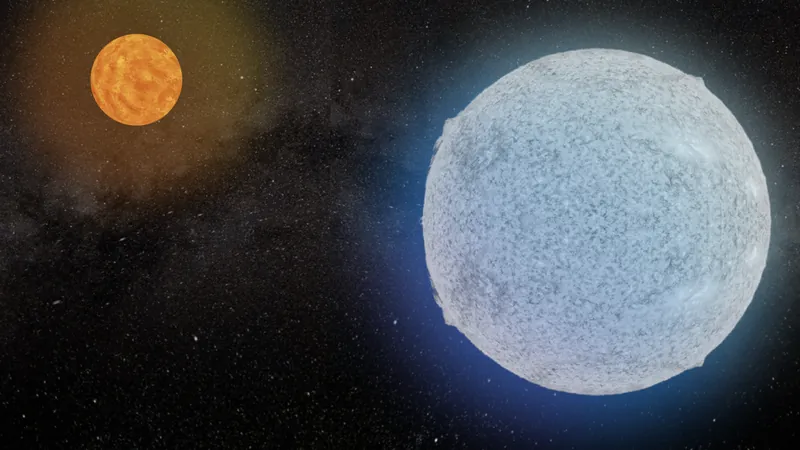
Has a Star Dodged a Stellar Fate? New Insights into the Mystery of a 'Monster' White Dwarf!
2024-09-17
In an exciting new study, scientists have cast doubt on the identity of a mysterious "dead star" residing in a binary system, suggesting that it might actually be a massive white dwarf rather than a neutron star, as previously believed. This revelation raises intriguing questions about the survival of its active stellar companion in such perilous proximity to what could be a voracious cosmic predator.
Located 417 light-years from Earth, this enigmatic star system—designated LAMOST J2354 after the Large Sky Area Multi-Object Fiber Spectroscopic Telescope (LAMOST) that first detected it—initially garnered attention because of its potential neutron star resident. However, new findings published on the pre-print repository Arxiv.org and soon-to-be featured in the Open Journal of Astrophysics indicate that the so-called stellar corpse may be much larger than previously thought.
Michael A. Tucker, a researcher at the Center for Cosmology and Astroparticle Physics at Ohio State University, led the investigation. “I was drawn to LAMOST J2354 because if it were a neutron star, it would have formed during a supernova explosion,” Tucker explained. Such a catastrophic event would ordinarily shower the living star with remnants, creating a detectable 'pollution' of metals. Yet, the team found no such evidence, leading them to consider the possibility of a white dwarf instead.
What’s the Difference? Understanding Stellar Remnants
So, what's the difference between a white dwarf and a neutron star? Both are the final evolutionary products of stars that have exhausted their nuclear fuel, yet they form under different circumstances. White dwarfs arise from stars similar to our Sun, while neutron stars are born from more massive stars that undergo supernova explosions.
The classification of LAMOST J2354 had been complicated because the mass of massive white dwarfs overlaps with that of lighter neutron stars. Tucker highlighted this challenge, “The mass of the 'heaviest' white dwarfs can blend with that of the 'lighter' neutron stars,” making definitive identification tricky.
The evidence pointing to LAMOST J2354's identity is compelling. The fact that the living star shows no signs of supernova debris suggests that it might have dodged a catastrophic fate. If the neutron star had indeed formed nearby, some elements from the exploded stellar progenitor would likely have contaminated the companion star.
Stellar Acrobats: The Case for Survival
One of the most captivating aspects of this binary system is its history of close encounters. Tucker elaborated on the common-envelope phase, a phenomenon wherein one star expands and engulfs its companion. This dramatic stage usually leads to a tightening of the system’s orbit as ejected material creates friction, but it typically results in a merger of the stars. Yet, in the case of LAMOST J2354, the smaller companion star avoided this fate, defying the odds.
“It’s remarkable that the living star managed to withstand two common-envelope phases without merging,” Tucker noted. Current models of binary stellar evolution would predict a different outcome, and the survival of such a close binary has implications for our understanding of stellar evolution.
Despite the intriguing clues favoring a white dwarf, the possibility of a neutron star cannot be entirely dismissed. The definitive answer likely lies in obtaining further observations from the Hubble Space Telescope, which will require patience, as time for observation is highly sought after.
As scientists work to unravel the mysteries of LAMOST J2354, one can't help but wonder: could this star system be a doorway into new understandings of stellar evolution and the cosmos? Only time and further discoveries will tell, but for now, this star has successfully evaded a deadly fate!



 Brasil (PT)
Brasil (PT)
 Canada (EN)
Canada (EN)
 Chile (ES)
Chile (ES)
 España (ES)
España (ES)
 France (FR)
France (FR)
 Hong Kong (EN)
Hong Kong (EN)
 Italia (IT)
Italia (IT)
 日本 (JA)
日本 (JA)
 Magyarország (HU)
Magyarország (HU)
 Norge (NO)
Norge (NO)
 Polska (PL)
Polska (PL)
 Schweiz (DE)
Schweiz (DE)
 Singapore (EN)
Singapore (EN)
 Sverige (SV)
Sverige (SV)
 Suomi (FI)
Suomi (FI)
 Türkiye (TR)
Türkiye (TR)